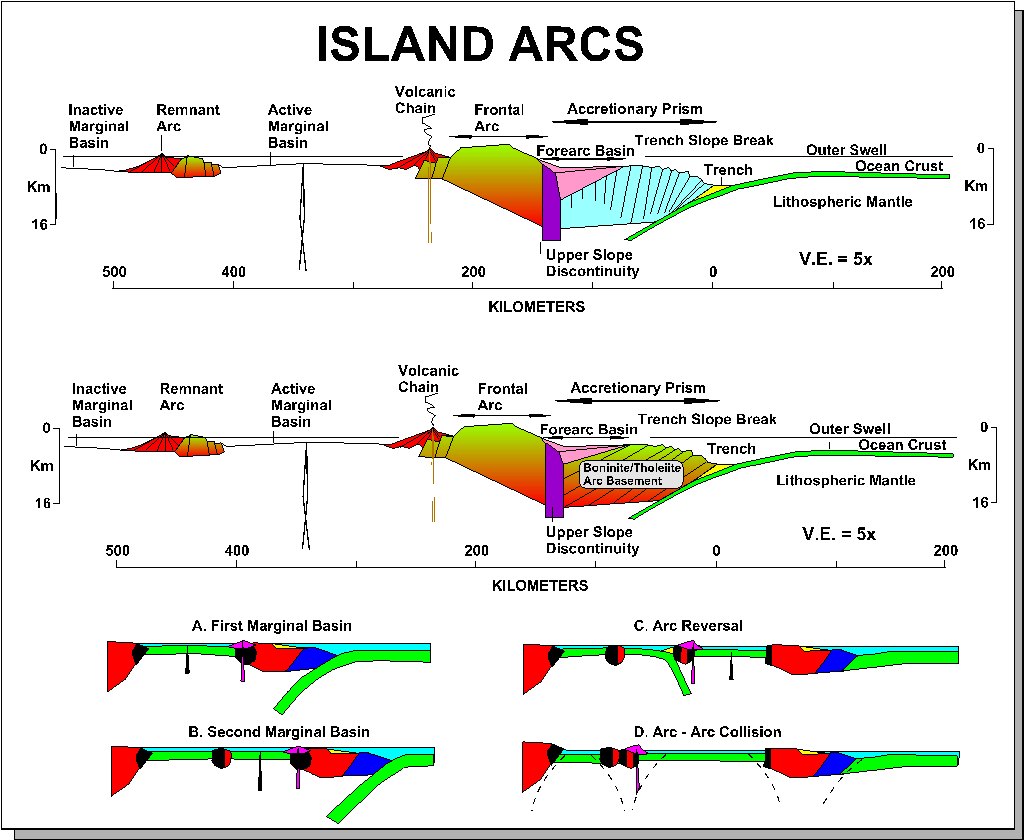Along destructive margins, fore-arc refers to linear areas seaward of continental or oceanic volcanic arcs and landwards of any accretionary prism or trench .
A subsiding forearc referred to as a fore-arc basin, rooted in either modified continental or oceanic crust. Bathymetrically, fore-arcs are rather variable. Most are shelf-like, with gentle slopes up to 100 km or more wide. Some are much more complex, with a plethora of sub-basins and local uplifted highs associated with both thrust and normal faulting. They act as sediment traps for the often prodigious sediment fluxes issuing from adjacent volcanic arcs. Volcanic airfalls, submarine slumps and eruption-driven turbidity currents transfer sediment downlope. Floating pumice rafts disperse more widely over the destructive margin. The efficiency of the fore-arc trap increases as ridge-like barriers form by accretionary offscrapping at the trench-slope break. The tendency with time is for the initially shallow fore-arc, with its coarse-grained basal deposits, to deepen quickly and then to infill gradually with a coarsening-upwards, predominantly turbiditic facies of arc volcanic provenance.
With time, the fore arc broadens and shallow by sediment onlap both oceanwards and landwards. The end result is an increasingly inefficient trap configuration. Basin fills from cainozoic and mesozoic example may reach up to 10km in thickness. The grat basin of california is perhaps the best exposed and investigated example of an ancient fore arc, whilst amongst active examples the sumatera-java fore-arc shows many classic features.
In order to understand how many fore arc basin originate as residual features superimposed upon older oceanic or continental-margin basement, it is necessary to conduct a thought experiment by imagining the likely sequence of events when subduction is initiated along a passive continental margin. During such a process, oceanic slab failure and reversely buoyant descent will occur oceanwards of the last thinned or modified continental crust. Fore-arcs are thus underlain by oceanic, modified oceanic or thinned continental crust, and bounded oceanwards by the first offscraped sediment of the nascent accretionary prism. Water depth are initially deep, liable to rapid infill by copious sediment flux from the adjacent arc.
Sediment loading induces extra flexural subsidence around the basin margin, causing forebulges, then waves of subsidence to migrate outwards towards both the trench-slope break and the volcanic arc, causing progressive onlap on those features. Fore-arc terrains along periodically extensional destructional margins undergo alternating uplift due to shortenng and subsidence as the area of the whole trench-arc gap episodically increases due to stretching.
Source : Leeder, Mike.1999.Sedimentology and Sedimentary Basins (From Turbulence to Tectonics). Blackwell Publishing. Malden (USA). page 520
keywords : Fore-arc basin, sedimentary basin, arc, sedimentology fore-arc
A subsiding forearc referred to as a fore-arc basin, rooted in either modified continental or oceanic crust. Bathymetrically, fore-arcs are rather variable. Most are shelf-like, with gentle slopes up to 100 km or more wide. Some are much more complex, with a plethora of sub-basins and local uplifted highs associated with both thrust and normal faulting. They act as sediment traps for the often prodigious sediment fluxes issuing from adjacent volcanic arcs. Volcanic airfalls, submarine slumps and eruption-driven turbidity currents transfer sediment downlope. Floating pumice rafts disperse more widely over the destructive margin. The efficiency of the fore-arc trap increases as ridge-like barriers form by accretionary offscrapping at the trench-slope break. The tendency with time is for the initially shallow fore-arc, with its coarse-grained basal deposits, to deepen quickly and then to infill gradually with a coarsening-upwards, predominantly turbiditic facies of arc volcanic provenance.
With time, the fore arc broadens and shallow by sediment onlap both oceanwards and landwards. The end result is an increasingly inefficient trap configuration. Basin fills from cainozoic and mesozoic example may reach up to 10km in thickness. The grat basin of california is perhaps the best exposed and investigated example of an ancient fore arc, whilst amongst active examples the sumatera-java fore-arc shows many classic features.
In order to understand how many fore arc basin originate as residual features superimposed upon older oceanic or continental-margin basement, it is necessary to conduct a thought experiment by imagining the likely sequence of events when subduction is initiated along a passive continental margin. During such a process, oceanic slab failure and reversely buoyant descent will occur oceanwards of the last thinned or modified continental crust. Fore-arcs are thus underlain by oceanic, modified oceanic or thinned continental crust, and bounded oceanwards by the first offscraped sediment of the nascent accretionary prism. Water depth are initially deep, liable to rapid infill by copious sediment flux from the adjacent arc.
Sediment loading induces extra flexural subsidence around the basin margin, causing forebulges, then waves of subsidence to migrate outwards towards both the trench-slope break and the volcanic arc, causing progressive onlap on those features. Fore-arc terrains along periodically extensional destructional margins undergo alternating uplift due to shortenng and subsidence as the area of the whole trench-arc gap episodically increases due to stretching.
Source : Leeder, Mike.1999.Sedimentology and Sedimentary Basins (From Turbulence to Tectonics). Blackwell Publishing. Malden (USA). page 520
keywords : Fore-arc basin, sedimentary basin, arc, sedimentology fore-arc
